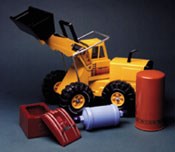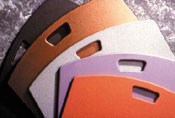Powder Coating Materials
Offer a world of colors, textures and effects...
In the past 10 years, research and development in powder coating materials has resulted in new formulations that have paved the way for powder in directions previously only accessible to liquid coatings.
Powder Types, Uses and Properties
There are two types of powder coatings: thermoplastic and thermoset. A thermoplastic powder coating is one that melts and flows when heat is applied but continues to have the same chemical composition once it cools and solidifies. Thermoplastic powders exhibit excellent chemical resistance, toughness and flexibility. They are applied mainly by fluidized beds. In this application method, parts are dipped into a vat where the powder is fluidized by air. This method is used in many thick-film applications.
Polyamides are nylon-based coatings that are durable, provide excellent chemical and solvent resistance and have outstanding appearance characteristics. They are used on dishwasher baskets, pipes, valves, medical instruments, outdoor applications and can also be formulated to be FDA compliant for food service applications. Polyethylene thermoplastics provide excellent chemical resistance and outstanding electrical insulation properties and are often used as coatings for laboratory equipment. Polypropylene thermoplastics produce a surface that is inert and often used where the powder coated part may be exposed to chemicals. Polyvinyl-chloride-based powders possess a good balance of properties and a soft, rubbery feel. They are used on dishwasher baskets and in food contact applications. Thermoplastic polyesters offer good exterior durability and weatherability, do not usually require a primer for good adhesion and are often used on outdoor metal furniture. PVDF (polyvinylidene fluoride) coatings are noted for outstanding exterior durability, have exceptional electrical insulating properties and are often used to coat pumps, valves and pipes.
Thermoset powder coatings are based on lower molecular weight solid resins and melt when exposed to heat. After they flow into a uniform thin layer, however, they chemically cross-link within themselves or with other reactive components to form a reaction product of much higher molecular weight. These newly formed materials are heat stable and, unlike the thermoplastic powders, will not soften back to the liquid phase when heated after curing. Resins used in thermoset powders can be ground into fine particles necessary for spray application and a thin film finish. Most of the technological advancements in recent years have been with thermoset powders.
Thermoset powders are derived from three generic types of resins: epoxy; polyester; and acrylic. From these resin types, several coating systems are derived. Epoxy-resin-based systems are used for both functional and decorative coatings. They offer outstanding corrosion resistance and electrical insulation, as well as attractive finishes that are flexible, tough and impact resistant. Typical applications include electrical components, automotive parts and rebar.
Epoxy-polyester-hybrid coatings are used mainly for decorative applications. They are more resistant to chalking and over-bake yellowing than pure epoxies but have a lower surface hardness and are less resistant to solvents. Hybrids also exhibit better transfer efficiency and a greater degree of penetration into recessed areas. Typical applications are shelving, oil filters, office furniture and power tools.
One of the new cross-linking systems introduced into the powder coating industry is hydroxy alkyl amides (HAA). These HAA polyesters provide weather-resistant finishes with excellent first-pass transfer efficiency and good charging characteristics. They are available in semi- to high gloss. These powders are used for lawn furniture, architectural products and other outdoor applications.
Polyester-TGIC coatings contain a polyester resin cross-linked with triglycidyl isocyanurate (TGIC) as a curing agent. These powders offer excellent mechanical properties, impact strength and weather resistance. They are resistant to chalking and are often used for such outdoor applications as patio furniture, lawn mowers and aluminum extrusions and panels for large commercial buildings.
GMA acrylic powders have fast- or low-temperature cure profiles and strong weatherability. They exhibit excellent clarity and are well suited as clearcoats on brass and chrome in addition to their use as pigmented powder coatings. Typical applications are microwave cavities, automotive trim, wheels and plumbing fixtures.
Acrylic urethane coatings are formulated with acrylic resins cross-linked with blocked isocyanates. They have excellent color, gloss, hardness, weatherability, chemical resistance and an excellent thin film appearance but are less flexible than polyesters.
Polyester urethane coatings are formulated with polyester hydroxyl resin combined with blocked isocyanate hardeners. Polyurethane powders exhibit outstanding thin film appearance and toughness as well as good weathering properties.
Appearance Characteristics
Color variety is almost limitless these days; with many coating suppliers offering a pallet of off-the-shelf colors as well as custom color match services to better meet the needs of small-volume powder users. There are also tints that can add highlight color to a substrate or base coat, such as a brass look over polished aluminum.
A range from flat to high gloss is generally available. Smooth, high-gloss coatings can offer high distinctness of image, creating an illusion of depth or wet looks. Matte finishes can hide surface defects or imperfections such as spot-welds, nicks and scratches on a variety of substrates.
Hammertones or veins give antique or distressed looks created by a black base with metallic pigments of gold, silver or copper contrasting against the black. This weathered look is popular in the furniture and display industries that demand a broad range of multicolor looks, including granite, confetti, rusty and weathered appearances.
Clear powders are often used as an external protective layer on many brass products such as doorknobs, hinges, railings, lamps and plumbing fixtures. There are also powders available that can substitute for chrome and brass plating in certain applications. Auto manufacturers, such as BMW and Volvo, are now using powder clearcoats over automotive exterior basecoats, a technology that is also being tested by the Big Three.
Powder coated finishes can now offer an icy or fluorescent appearance or the lustrous look of a pearl that may appear to change color depending on the angle of observation. Bicycles, wheel rims, garden tools, light fixtures and some glass products benefit from this look.
Photoluminescent powder coatings are able to absorb ultraviolet, fluorescent or incandescent light and gradually re-emit that light. These are often available in blue, yellow and green and are used for road signs, hazard warnings and markings on trucks, buses and police cars.
Metallic coatings add sparkling highlights that can reproduce the appearance of the base metal and add richness to the look of the product. A variety of metallic finishes have been formulated for indoor and outdoor furniture, exercise equipment, lawn and garden tools and other products that can resemble the look of gold, chrome or brass.
Textured coatings are often used to hide substrate irregularities that may show with a smooth finish, provide a non-slip surface or hide fingerprints while giving a distinctive feel to a product. Appearances vary from the look of fine sandpaper to a pebbly texture to a rougher look resembling alligator skin.
Wrinkle finishes are a special class of textures that offer styling variation and a consistent appearance. They exhibit excellent resistance to high wear and weatherability conditions seen with tools, exercise equipment and shop displays.
Performance Characteristics
Recent research and testing has developed specially formulated polyester powders that provide even greater weatherability than achievable in previous years and show greater success in long-term Florida exposure testing. New TGIC-based powders are used on outdoor stadium seating and other exterior applications that were previously susceptible to degradation from UV rays. Light poles, lawn furniture, shopping carts and shelving often benefit from powder with Teflon additives for increased resistance to abrasion.
Makers of electronic components sometimes use electroconductive and electrodissipative powder coatings, which provide electrostatic discharge protection of the components, critical during the manufacture, testing and transport of electronic goods. The most common colors for these special powders are black and charcoal, but lighter colors are also available.
In recent years, ongoing research and development has been devoted to formulating powders that can cure at lower temperatures, below 212F, without compromising durability or quality. These powders can be used on temperature-sensitive materials as well as on massive parts that require enormous amounts of energy to be cured. More wood materials, such as particle board and fiberboard as well as glass and plastic products, can benefit from a powder-coated finish. This technology has helped to penetrate markets for office furniture, kitchen cabinets and ready-to-assemble furniture for homeowners. Pre-assembled components, such as electrical motors, shock absorbers, foam core doors and other products that may have plastics, laminations, electrical wires or rubber seals, can now also receive a powder coated finish. In addition, heat-sensitive alloys, such as magnesium, can now be powder coated.
Recently developed antibacterial powders can help prevent the spread of bacteria on products in homes, hospitals, restaurants and food processing plants.
Silicone-based powder coatings are often used on products that are subjected to prolonged periods of high heat, up to 1,000F, yet hold their color, gloss and adhesion. Some of these products include gas and charcoal grills, fireplace inserts, engine exhaust components and lighting fixtures.
Powder manufacturers are developing more powders for use in thin-film applications that may range from 0.8-1.2 mil. These powders offer more with less—better powder penetration into recesses, more film thickness control and more effective first-pass transfer efficiency with darker colors that are most effective in hiding the substrate underneath.
Specially formulated powders can cure by UV radiation in a matter of seconds, which is one way to cure products with heat-sensitive substrates or components. Many wood products have enough moisture content to provide sufficient conductivity, and electrostatic attraction can be increased by pretreating and preheating the wood to promote adhesion.
Other specially formulated powders can be cured in a matter of seconds through near-infrared technology, due to the extremely high heat-up rate. These powders can even work on some heat-sensitive materials because the irradiated energy is almost entirely absorbed by the powder coating layer.
Just as powder coatings can now be used in applications once thought impossible just a few years ago, continued advancements in powder coating formulation will ensure greater powder penetration in markets and on substrates in the near future that are currently thought to be unattainable.
Read Next
A ‘Clean’ Agenda Offers Unique Presentations in Chicago
The 2024 Parts Cleaning Conference, co-located with the International Manufacturing Technology Show, includes presentations by several speakers who are new to the conference and topics that have not been covered in past editions of this event.
Read MoreEpisode 45: An Interview with Chandler Mancuso, MacDermid Envio Solutions
Chandler Mancuso, technical director with MacDermid Envio discusses updating your wastewater treatment system and implementing materials recycling solutions to increase efficiencies, control costs and reduce environmental impact.
Read MoreDelivering Increased Benefits to Greenhouse Films
Baystar's Borstar technology is helping customers deliver better, more reliable production methods to greenhouse agriculture.
Read More





















.jpg;maxWidth=300;quality=90)



